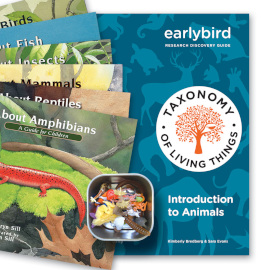Taxonomy of Living Things: Introduction to Animals is the title of both the Earlybird Research Discovery Guide for this course and a bundle of resources required for use with the guide. The goal of the course is to teach children about the animal kingdom while simultaneously providing non-fiction writing prompts. The publisher recommends using the bundle with second graders, but it should also work well for third graders.
In addition to the guide, the bundle includes six picture books and a small, tin box with 19 miniature animals representing various phyla. The picture books are all from the “A Guide for Children” series written by Cathryn Sill and illustrated by John Sill. The titles of the six books are:
- About Amphibians
- About Birds
- About Fish
- About Insects
- About Mammals
- About Reptiles
The books feature beautifully detailed illustrations of many different creatures, usually within their habitats. The books are laid out with illustrations on the right-hand page and no more than one sentence of text on the left. An “Afterword” section toward the back of each book has four or six pages with reduced images of the illustrations, each accompanied by a paragraph of text with much more information. A glossary follows the Afterword section.
If teaching more than one child, each one needs his or her own copy of the Earlybird Research Discovery Guide since it is not reproducible. Children will write, draw, and color directly in it using colored pencils that you supply.
The first week of the course introduces taxonomy with lessons in the guide that gradually narrow the classification system to various phyla within the animal kingdom. The miniature animals are used during these lessons. After that, each picture book is used for two weeks, for a total course time of 13 weeks.
During the first week of study for each picture book, the guide says to read the book and then have students answer comprehension and vocabulary questions. Students are sometimes directed to look in the Afterword of the current picture book for information to answer questions, and they will choose one word from the glossary of each book to copy along with its definition.
For the second week of study of each picture book, the guide has the same three pages that focus more on writing and creativity. The first is a graphic organizer that helps students think about ways to describe attributes of the phylum. Using that information, students write four descriptive sentences on the next page. On the third page, they draw a picture of their favorite animal representing that phylum.
The study can be used in an open-and-go fashion, and parents can assist students with writing and spelling as needed.
Summary
Taxonomy of Living Things: Introduction to Animals provides a practical way for parents to use the beautiful picture books to develop an introductory understanding of taxonomy and the animal kingdom while also developing skills for writing non-fiction.









